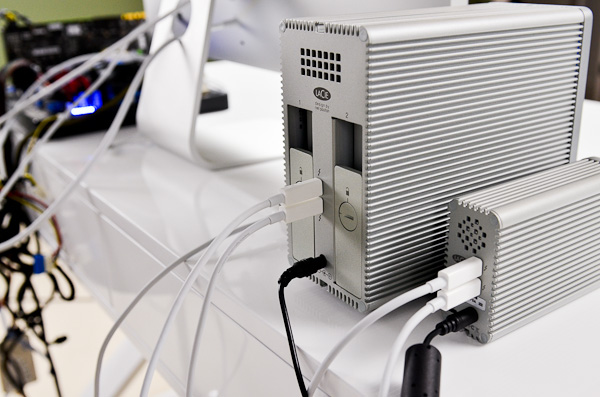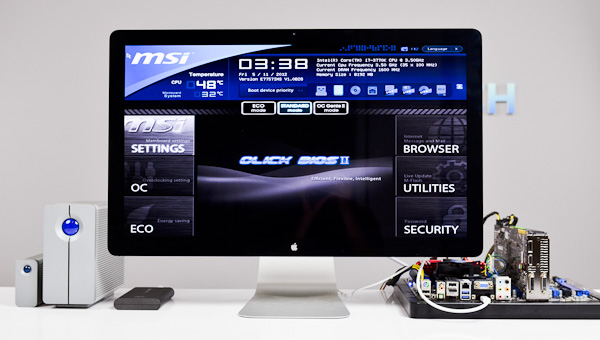A First Look at Thunderbolt on Windows with MSI's Z77A-GD80
by Anand Lal Shimpi on May 11, 2012 1:32 PM EST- Posted in
- Motherboards
- CPUs
- Intel
- MSI
- Thunderbolt
The Storage Devices & Performance
Other than Apple's Thunderbolt Display, every other TB device we've tested has been some sort of storage device. In my lab I've got Promise's Pegasus R6, LaCie's 2big and Little Big Disk (SSD), Seagate's GoFlex Thunderbolt adapter and Elgato's Thunderbolt SSD. With the exception of the Pegasus R6, which currently lacks Windows drivers, all of the storage devices I tested worked with MSI's Z77A-GD80 under Windows. Although there are workarounds for getting the Pegasus up and running under Windows, I encountered a number of hangs and general system unhappiness whenever I tried them on this platform. I suspect this has something to do with why Promise has yet to officially release Windows drivers for the Pegasus.
The rest of the storage devices, as you would expect, just worked. I didn't need to install any drivers as all of their internal controllers had native support under Windows 7. Again, I couldn't hot plug any of these devices once Windows was running - all of them had to be present at boot.
Just as I've seen under OS X, with complex Thunderbolt chains you'll sometimes have a device that hangs in the chain and prevents some or all TB devices from working. I did encounter this behavior more frequently under Windows than I did under OS X. Keep in mind that every single Thunderbolt device on the market today was pretty much developed and tested against Macs, it's going to be a little while before we get perfect behavior under Windows. We don't even have perfect behavior under OS X yet either. My hope is that as more platforms ship with Thunderbolt support, and as we get more Thunderbolt devices, compatibility and behavior validation will both improve. I've also heard that the early Thunderbolt controllers were more finicky than Cactus Ridge, so it's possible that newer TB devices that come out this year will just inherently be better behaved. This is purely hearsay however, I don't have any hard evidence to back it up.
Update: Intel tells us that an updated Pegasus driver is in the works that will address the issues we've seen. Other finicky behavior is also expected to be addressed through the Thunderbolt on Windows certification process.
Since I couldn't get the Pegasus working, I had to resort to combining a bunch of my other Thunderbolt storage devices to measure performance. I created a chain combining LaCie's 2big, the SSD Little Big Disk and Elgato's Thunderbolt SSD along with Apple's Thunderbolt Display. I ran a 128KB sequential read test at a queue depth of 32 across all of the drives, while pushing the Thunderbolt Display at its native 2560 x 1440 resolution:
The best I ever got under OS X was 8Gbps using four SandForce SSDs in the Promise Pegasus. At 7Gbps using a far less elegant setup, this isn't bad at all. Keep in mind that while we're reading at 7Gbps, the GD80 was also using around 7Gbps of bandwidth to drive the Thunderbolt Display at 2560 x 1440. Total available bandwidth for a single-port Thunderbolt device is 20Gbps bi-directional (40Gbps total), so there's still additional headroom available.
Moving Forward
MSI's Z77A-GD80 finally brings Thunderbolt to Windows desktops. With a few exceptions, the experience is quite similar to OS X. The major differences are that some devices clearly need more compatibility testing with these new platforms, and that you can't hot plug Thunderbolt devices under Windows. The former is solvable given additional time, while the latter can be more annoying in the long run if a workaround isn't found. For a single, high-speed storage device under Windows, USB 3.0 is going to be the simplest route. It's only when you want to start pushing even more bandwidth and/or add a display into the mix that Thunderbolt becomes your only solution.
Thunderbolt's functionality otherwise looks very similar under Windows as it does under OS X. The interface doesn't require any specific drivers and in the best conditions it just works. Thunderbolt's behavior remains quite finicky however, even more so under Windows. You'll want to wait for either the next generation of Thunderbolt devices or for the current device vendors to get some more time validating their Thunderbolt products on Windows platforms. Given that the first Thunderbolt equipped PC motherboards haven't even shipped yet, you've got some time.
Update: Intel has informed us that we will see updated drivers for Windows certified Thunderbolt devices that will enable hot plugging under Windows. Intel further informed us that MSI's board has not yet made it through the certification process and a lot of these teething issues will hopefully be addressed by then.
For much of the past year I've been calling for cheaper Thunderbolt storage devices, but with the arrival of Thunderbolt on Windows I'll modify my plea: we need more Thunderbolt display devices as well. As the desktop PC evolves, it would be nice to have only a single cable running from your PC to a Thunderbolt equipped display that acts as the IO hub for all of your peripherals. I'm thinking of something like Apple's Thunderbolt Display, but even heavier on the expansion side and with OS-independent display controls.













98 Comments
View All Comments
ggathagan - Friday, May 11, 2012 - link
Did you read the second page?Ivybridge chipsets utilize Virtu software to allow you to switch between the IGP and a discrete GPU without having to physically switch the display connections.
The display can be attached to either the motherboard connection or the dGPU connection and Virtu will allow you to use use the dGPU for gaming, while utilizing the IGP for less strenous uses.
As Anand clearly stated, you can use the TB connection for your display and that process still works properly.
Zoomer - Friday, May 11, 2012 - link
HD 4000 as clearly mentioned in the article.Death666Angel - Monday, May 14, 2012 - link
And GTX680 when firing up games....Ujjwal Tiwari - Friday, May 11, 2012 - link
I couldn't quite grab it from the article, Was it possible to play games from gtx 680 on mac display through TB port? Or was another normal display used to connect to graphics card? And how in the hell are we supposed to run gpu intensive apps through HD 4000 only?? (Assuming we use mac display as only display?)Zoomer - Friday, May 11, 2012 - link
Yes with Virtu.ggathagan - Friday, May 11, 2012 - link
Yes.No.
Read the second page and read up on Ivy Bridge and Virtu!
The only difference between this and a non-TB motherboard is that you have yet another connection that can be used for your display.
Nothing else changes with regard to how the IGP and dGPU work on an Ivy Bridge board.
ggathagan - Friday, May 11, 2012 - link
If there's one market besides mobile where ThunderBolt could really take off, it's in the corporate world.Just think how inexpensive it could be if someone like Dell or HP were to take the following approach:
You put out a line of computers and monitors where all the connectivity is at the display.
There would no longer be any need to build network, USB, Firewire or even sound into the motherboard.
This reduces the computer itself to nothing more than the CPU, memory, GPU and storage.
Even the storage could be separately housed.
That makes for a tiny foot print and your customers can now upgrade their computers to the latest-and-greatest CPU/GPU with no more effort than it takes to plug in the TB cable and the power cord.
This is also applicable to the HTPC community if someone ends up marketing TB-equipped TV's.
descendency - Saturday, May 12, 2012 - link
Wow. Cool. I'm not really interested in this in the desktop area, but a laptop... yes. Just yes.If Lenovo reads this, an Thinkpad X2xx tablet with this is a day 1 pre-order. I can't imagine how awesome this will be when it gets into the market at large.
Wardrop - Saturday, May 12, 2012 - link
Making the monitor the interconnect hub for a computer does make sense. You're more likely to move around a computer than a monitor. Portability doesn't just refer to laptops and using your computer away-from-a-desk. Portability for me means moving a computer from one desk to another. This is especially applicable at my place of work, where I have technical requirements that exceed the capabilities of a laptop, but where I need to move between offices which have a hotdesks with monitor, keyboard and mouse.Basically, all of the logic should reside in the computer, but the monitor should act as the consolidation point for all the copper connecting your devices to your computer. I wouldn't like to see the monitor have any intelligence, with thunbderbolt (the carrier) being the exception.
Impulses - Saturday, May 12, 2012 - link
TB displays are great for laptop users but they're not a prefect solution for everyone... Any power user that has multiple displays probably doesn't care a whole lot for having a bunch of peripheral connections hanging off displays that are possibly wall or arm mounted. The holy grail for TB is still being able to offer that powerful external GPU that makes a thin and light laptop a gaming machine at home imo, but we seem to be a long way off from that.